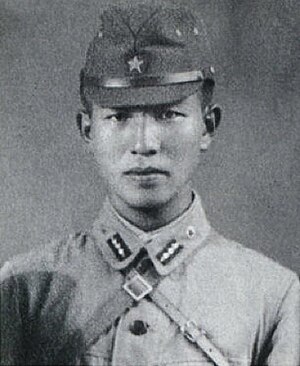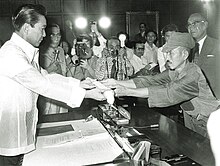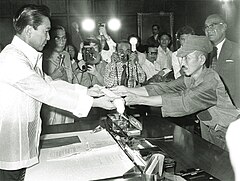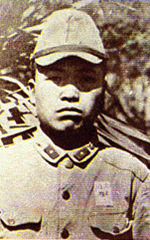1,762 엔 (본체 가격 1,602 엔)
ISBN 4-8083-0535-6
전시 간을 판上製240P
[재고 있음]
30 년의 고독하게 참아 루반구 섬에서 생환 한 오노 전 소위의 자서전.
조국의 패전을 믿지 않고 필리핀 루방 섬에서 30 년간 "항전"을 계속했다 오노 전 소위의 자서전.
1974 년 3 월 수색에 온 스즈키 청년과 만나 전 상관의 "투항 명령"에서 생환했을 때 전 세계에 큰 충격을주었습니다. 귀환 후에도 평화 노망 한 일본에 붙이지 않고 브라질로 이주 목장을 경영하고 있습니다 만, 일본에서도 "자연과 인간" "위기 관리"를 주제로 「오노 자연 학원」를 주재 청소년의 육성에 힘 을 넣고 있습니다.
30 년의 고독으로 태어난 개는 무엇이고, 평화로운 일본 생활에 붙이지 않았던가. 이 전례없는 경험과 인생관은 매우 재미 있고 꼭 일독을 권하고 싶습니다 설명서입니다.
[주요 내용]
브라질에서 맞이한 전후 50 년의 정월, 빚을 짊어지고 살, 오노 목장과 가축 도둑의 것을 스즈키 소년과의 만남, 역사의 우연, 베트남 전쟁, 전 상관으로부터 항복 명령, 안녕히 전장 20 세까지였다 청춘 소집 된 나카노 학교에 운명의 섬 루방 섬, 적병의 상륙 투항 빌라,残置꾀에게 총과蛮刀게릴라 시마다 전사 구호 활동도 모략 믿고 어머니의 편지, 성혼 뉴스도, 옷 수선 및 조달, 라디오 입수, 코즈 카의 전사, 목숨 값 ... 게다가.
Hiroo Onoda
Hiroo Onoda | |
|---|---|
 Onoda, c. 1944 | |
| Born | 19 March 1922 Kainan, Wakayama, Empire of Japan |
| Died | 16 January 2014 (aged 91) Tokyo, Japan |
| Allegiance | |
| Service/ | |
| Years of service | 1942–1945 (1974) |
| Rank | Second lieutenant |
| Battles/wars | World War II |
| Other work | Cattle farmer Entrepreneur (Education) |
Hiroo Onoda (Japanese: 小野田 寛郎, Hepburn: Onoda Hiroo, 19 March 1922 – 16 January 2014) was an Imperial Japanese Army intelligence officer who fought in World War II and was a Japanese holdout who did not surrender at the war's end in August 1945. After the war ended Onoda spent 29 years hiding out in the Philippines until his former commander travelled from Japan to formally relieve him from duty by order of Emperor Shōwa in 1974.[1][2] He held the rank of second lieutenant in the Imperial Japanese Army. He was the penultimate Japanese soldier to surrender, with Teruo Nakamura surrendering later in 1974.
Early life[edit source]
Onoda was born on 19 March 1922, in Kamekawa Village, Kaisō District, Wakayama Prefecture, Japan. When he was 17 years old, he went to work for the Tajima Yoko trading company in Wuhan, China.[3][4] When he was 18, he was enlisted in the Imperial Japanese Army Infantry.[3]
Military service[edit source]
Onoda trained as an intelligence officer in the commando class "Futamata" (二俣分校, futamata-bunkō) of the Nakano School. On 26 December 1944, he was sent to Lubang Island in the Philippines.[5] He was ordered to do all he could to hamper enemy attacks on the island, including destroying the airstrip and the pier at the harbor. Onoda's orders also stated that under no circumstances was he to surrender or take his own life.
When he landed on the island, Onoda joined forces with a group of Japanese soldiers who had been sent there previously. The officers in the group outranked Onoda and prevented him from carrying out his assignment, which made it easier for the United States and Philippine Commonwealth forces to take the island when they landed on 28 February 1945. Within a short time of the landing, all but Onoda and three other soldiers had either died or surrendered. Onoda, who had been promoted to lieutenant, ordered the men to take to the hills.
Time in hiding[edit source]
Onoda continued his campaign as a Japanese holdout, initially living in the mountains of Lubang Island in the Philippines, with three fellow soldiers (Private Yuichi Akatsu, Corporal Shōichi Shimada and Private First Class Kinshichi Kozuka).[6] During his stay, Onoda and his companions carried out guerrilla activities and engaged in several shootouts with the local police.[7]
The first time they saw a leaflet announcing that Japan had surrendered was in October 1945; another cell had killed a cow and found a leaflet left behind by islanders which read: "The war ended on 15 August. Come down from the mountains!"[8] However, they distrusted the leaflet. They concluded that it was Allied propaganda and also believed that they would not have been fired on if the war had indeed been over. Toward the end of 1945, leaflets were dropped by air with a surrender order printed on them from General Tomoyuki Yamashita of the Fourteenth Area Army. To the men who had been in hiding for over six months, this leaflet was the only evidence they had that the war was over. Onoda's group studied the leaflet closely to determine whether it was genuine, and decided it was not.[1][failed verification]
One of the four soldiers, Yuichi Akatsu, walked away from the others in September 1949 and surrendered to Philippine forces in 1950, after six months on his own. This seemed like a security problem to the others and they became even more cautious. In 1952, letters and family pictures were dropped from an aircraft urging them to surrender, but the three soldiers concluded that this was a trick. Shimada was shot in the leg during a shoot-out with local fishermen in June 1953, after which Onoda nursed him back to health. On 7 May 1954, Shimada was killed by a shot fired by a search party looking for the men. Kozuka was killed by two shots fired by local police on 19 October 1972[7] while he and Onoda, as part of their guerrilla activities, were burning rice that had been collected by farmers. Onoda was now alone.
On 20 February 1974, Onoda met a Japanese man, Norio Suzuki, who was traveling around the world, looking for "Lieutenant Onoda, a panda, and the Abominable Snowman, in that order".[4] Suzuki found Onoda after four days of searching. Onoda described this moment in a 2010 interview: "This hippie boy Suzuki came to the island to listen to the feelings of a Japanese soldier. Suzuki asked me why I would not come out...".[1] Onoda and Suzuki became friends, but Onoda still refused to surrender, saying that he was waiting for orders from a superior officer. Suzuki returned to Japan with photographs of himself and Onoda as proof of their encounter, and the Japanese government located Onoda's commanding officer, Major Yoshimi Taniguchi, who had long surrendered and since become a bookseller. Taniguchi went to Lubang Island, and on 9 March 1974, he finally met with Onoda and fulfilled a promise he had made back in 1944: "Whatever happens, we'll come back for you". Taniguchi then issued Onoda the following orders:
Onoda was thus properly relieved of duty, and he surrendered. He turned over his sword, a functioning Arisaka Type 99 rifle, 500 rounds of ammunition and several hand grenades, as well as the dagger his mother had given him in 1944 to kill himself with if he was captured.[10] Only Private Teruo Nakamura, arrested on 18 December 1974 in Indonesia, held out longer.
Later life[edit source]
Onoda was so popular following his return to Japan that some people urged him to run for the Diet (Japan's bicameral legislature). He also released an autobiography, No Surrender: My Thirty-Year War, shortly after his return, detailing his life as a guerrilla fighter in a war that was long over. A Philippine documentary interviewed people who lived on Lubang Island during Onoda's stay, revealing that Onoda had killed several people, which he had not mentioned in his autobiography.[11] The news media reported this and other misgivings, but at the same time welcomed his return home. The Japanese government offered him a large sum of money in back pay, which he refused. When money was pressed on him by well-wishers, he donated it to Yasukuni Shrine.
Onoda was reportedly unhappy being the subject of so much attention and troubled by what he saw as the withering of traditional Japanese values. In April 1975, he followed the example of his elder brother Tadao and left Japan for Brazil, where he raised cattle. He married in 1976 and assumed a leading role in the Colônia Jamic (Jamic Colony), a Japanese community in Terenos, Mato Grosso do Sul, Brazil. Onoda also allowed the Brazilian Air Force to conduct training sessions on the land that he owned.[12] After reading about a Japanese teenager who had murdered his parents in 1980, Onoda returned to Japan in 1984 and established the Onoda Shizen Juku ("Onoda Nature School") educational camp for young people, held at various locations in Japan.[13]
Although Hiroo Onoda never apologized or expressed any remorse for killing about 30 Filipino civilians (mostly farmers), stealing their food and burning their crops, then-President Ferdinand Marcos granted him a full pardon, in a televised ceremony.[14][15] As a result, controversy followed when Onoda revisited Lubang Island in 1996, because his wife Machie Onoda (née Honoku) had arranged a US$10,000 scholarship donation on his behalf to the local school there. In 2006, Machie Onoda became the head of the right-wing conservative Japan Women's Association (JWA), established by the far-right group Nippon Kaigi in September 2001.[16]
For many years, Onoda spent three months of the year in Brazil. Onoda was awarded the Merit medal of Santos-Dumont by the Brazilian Air Force on 6 December 2004.[17] On 21 February 2010, the Legislative Assembly of Mato Grosso do Sul awarded him the title of Cidadão ("Citizen").[18]
Death[edit source]
Onoda died of heart failure[19] on 16 January 2014, at St. Luke's International Hospital in Tokyo, due to complications from pneumonia.[20] Japanese Chief Cabinet Secretary, and current Prime Minister, Yoshihide Suga, commented on his death: "I still vividly remember that I was reassured of the end of the war when Mr. Onoda returned to Japan" and also praised his will to survive.[19]
Works[edit source]
Books
- わがルバン島の30年戦争 [30 Years War on the Island of Lubang]. Tokyo: 講談社 [Tokyo Kōdansha], 1974. OCLC 976947108. 248 pages.
- No Surrender: My Thirty-Year War. Translated by Charles S. Terry. New York: Dell Publishing, 1974. ISBN 978-1-55750-663-4, OCLC 6547712. 251 pages.
Interviews
- Hiroo Onoda describes his private thirty years of war against the United States. Broadcast on The Mike Douglas Show, February 14, 1975. OCLC 27191000
See also[edit source]
- List of Japanese holdouts
- List of solved missing person cases
- Shoichi Yokoi discovered on the island of Guam, 1972
- Siege of Baler
- Survival skills
- Teruo Nakamura discovered December 1974, Morotai Island, Indonesia
- Onoda, 10 000 Nights in the Jungle, a 2021 film
Footnotes[edit source]
- ^ a b c Willacy, M. (2010): Japanese holdouts fought for decades after WWII ABC Lateline (12 November 2010). Retrieved on 16 September 2011.
- ^ Powers, D. (2011): Japan: No Surrender in World War Two BBC History (17 February 2011). Retrieved on 16 September 2011.
- ^ a b Brown, P. (2010): Hiroo Onoda's Twenty Nine Year Private War Archived 3 December 2013 at the Wayback Machine Pattaya Daily News (15 June 2010). Retrieved on 16 September 2011.
- ^ a b 2nd Lt. Hiroo Onoda (c. 2010). Retrieved on 3 April 2011.
- ^ Kawaguchi, J. (2007): Words to live by: Hiroo Onoda The Japan Times (16 January 2007). Retrieved on 16 September 2011.
- ^ "Hiroo Onoda – obituary". The Daily Telegraph. 19 January 2014. Retrieved 19 January 2014.
- ^ a b McFadden, Robert, Hiroo Onoda, whose war lasted decades, dies at 91, The New York Times, 18 January 2014, p.18
- ^ Onoda 1999, p. 75.
- ^ Onoda 1999, pp. 13–14
- ^ "Hiroo Onoda: Last man fighting". The Economist. 25 January 2014. Retrieved 5 February 2014.
- ^ "i-Witness – Ang Huling Sundalong Hapon (Part 3 of 4)". Retrieved 26 September2012.
- ^ "Brazilian Report on Hiroo Onoda". Brazilian Air Force. 8 December 2004. Archived from the original on 11 March 2005. Retrieved 11 March 2005.
- ^ Mercado, Stephen C. (2003). The Shadow Warriors of Nakano. Brassey's. pp. 246–247. ISBN 1-57488-538-3.
- ^ "Japan WW2 soldier who refused to surrender Hiroo Onoda dies". BBC News. 17 January 2014. Retrieved 17 January 2014.
- ^ Thurber, David (22 May 1996). "Town Seeks Compensation from Japanese WWII Straggler". AP NEWS. Archived from the original on 18 March 2021. Retrieved 18 March 2021.
- ^ "Wife of 'No Surrender' soldier becomes president of conservative women's group". Japan Probe. 29 November 2006. Archived from the original on 11 July 2009.
- ^ "Combatente da II Guerra ganha medalha da FAB" (in Portuguese). Brazilian Air Force Centro de Comunicação Social da Aeronáutica Center for Social Communication of the Air. 8 December 2004. Archived from the original on 11 March 2005. Retrieved 7 May 2009.
- ^ "Herói japonês que mora em Terenos recebe homenagem" (in Portuguese). A Crítica. 21 February 2010.
- ^ a b McCurry, Justin (17 January 2014). "Hiroo Onoda: Japanese soldier who took three decades to surrender, dies". The Guardian. Retrieved 17 January 2014.
- ^ Mullen, Jethro and Yoko Wakatsuk (17 January 2014). "Hiroo Onoda, Japanese soldier who long refused to surrender, dies at 91". CNN. Retrieved 17 January 2014.
Works cited[edit source]
- Hiroo Onoda (1999). No Surrender: My Thirty-Year War. Translated by Terry, Charles S. New York: Dell. ISBN 978-1-55750-663-4.
Further reading[edit source]
- Robert D. McFadden, "Hiroo Onoda, Soldier Who Hid in Jungle for Decades, Dies at 91," New York Times, 17 January 2014.
External links[edit source]
| Wikiquote has quotations related to: Hiroo Onoda |
- Kawaguchi, Judit (January 2007), "Words to Live by", Japan Times (interview).
- Thirty Years in the Jungle! Could you do it? (biography), Primitive Ways (also with Shoichi Yokoi).
- Bellows, Alan, The Soldier Who Wouldn't Quit, Damn Interesting.
- Onoda Shizen Juku (in Japanese)
- Article and 5:57 minute video of a 2010 news broadcast showing interview with 88-year-old Onoda, his wife, color footage of when he left the jungle in 1974, etc. abc.net.au
- Taylor, Alan. Image No. 45 (last at bottom): Photo of Onoda wearing his sword, on his last day before being relieved, with narrative caption, World War II: After the War, A Retrospective in 20 Parts. The Atlantic, 30 October 2011.
- "The War is Over... Please Come Out: Japanese Soldier Surrenders 29 Years After the End of World War II", History: 1900s, About.
- Hiroo Onoda obituary The Daily Telegraph.
- Hiroo Onoda fought WWII For 30 Additional Years (video)
오노다 히로
| 이 문서의 내용은 출처가 분명하지 않습니다. (2014년 8월) |
小野田寛郎 | |
 육군사관 시절의 오노다 히로 | |
| 생애 | 1922년 3월 19일 ~ 2014년 1월 16일 |
|---|---|
| 출생지 | 일본 제국 와카야마현 가이난시 |
| 사망지 | 일본 도쿄 |
| 복무 | 일본 제국 육군 |
| 복무 기간 | 1942년 ~1945년 (1974년) |
| 최종 계급 | |
| 근무 | 필리핀 군사령부 참모부 일본 제국 육군 8사단 참모부 |
| 주요 참전 | 루방섬 |
| 서훈 내역 | 남수포장 |
| 기타 이력 | 목장 경영자 |
오노다 히로(일본어: 小野田寛郎, 1922년 3월 19일 ~ 2014년 1월 16일)는 일본의 군인이다. 제2차 세계 대전 종전 이후에도 29년 동안 필리핀의 정글에 숨어서 항복하지 않았던(잔류일본병) 장교로 잘 알려져 있다.
생애[편집]
은거[편집]
오노다 소위는 필리핀 루방 섬에 주둔하고 있던 제14방면군의 정보장교였다. 1945년 2월 연합군이 루방섬을 점령하면서 대부분의 일본군은 포로로 잡히거나 전사하였는데, 오노다 소위와 몇명은 정글 깊이 숨어 들었다. 오노다 소위는 처음에 세명의 동료와 함께 산에서 살았다. 그 중에 한명은 필리핀 정부군에 항복했고, 나머지 두명은 각각 1954년과 1972년에 지방 순찰대와 교전중에 총에 맞아 사망했다. 오노다 소위는 2차 대전이 끝났다는 사실을 인정하지 않고 끝끝내 29년 동안이나 투항을 거부하며 정글에서 홀로 지냈다. 2차 대전중 연합군이 살포한 선전물은 물론 2차대전이 끝나고 필리핀 정부군이 뿌린 '전쟁은 끝났으니 항복하라'는 내용의 선전물까지 자신들을 기만하는 계략이라고 굳게 믿었다. 일본 정부와 오노다의 가족들도 필리핀에 와서 항복을 권유했지만, 이것도 연합군의 계략이라고 생각하여 응하지 않았다. 결국 1960년 일본 정부는 오노다가 사망한 것으로 공식 판정했다.
그는 태평양 전쟁(필리핀 전역) 막바지인 1944년 겨울, 필리핀 마닐라 근처의 작은 루방 섬에 파견되었다. 그는 250명의 훈련되지 않은 병사를 이끄는 지휘관이었다. 오노나 소위는 미군의 루손 섬 공격을 지연시키기 위하여 비행장 활주로를 파괴한 후, 유격전을 벌이 명령을 명령을 받았다.
당시 8사단장 요코야마 시즈오는 떠나는 오노다 일행에게 말했다. 항복은 물론 옥쇄도 일절 허락하지 않는다. 몇 년이 걸리더라도 버텨야한다. 반드시 데리러 오마. 병사가 한 명이 남더라도 야자수 열매라도 따먹으며 끝까지 버텨라. 다시말하지만 항복은 물론 옥쇄도 허락하지 않는다. 이듬해 봄 미군이 상륙하면서, 화력에서 밀린 일본 주력군은 오노다의 군세를 남기고 패퇴하였다. 오노다의 부대는 첫 전투에서 207명이 전사했고, 나머지 43명은 산속으로 흩어졌다. 오노나 소위는 아카쓰 유이치(赤津勇一) 일등병, 시마다 쇼이치(島田庄一) 오장, 고즈카 긴시치(小塚金七) 상등병과 함께 주저 없이 산 속으로 들어가 유격전을 개시했다. 미군이 살포한 삐라 전단을 읽고 일본이 항복한 사실을 알게 된 나머지 20명은 투항하여 일본으로 돌아갔다. 그러나 오노다는 미군의 전단을 믿을 수가 없었다. 그는 그의 기억속의 명령에 따라 그때까지 그의 곁에 남아있던 시마다 오장과 고즈카 상등병을 데리고 유격전을 계속했다. 전쟁은 끝났다. 종전 다음해인 1946년 봄, 오노다 일행을 구하기 위해 일찍이 투항했던 오노다의 옛 부하들이 필리핀으로 가서 섬전체를 돌아다니며 외쳤다. “오노다, 오노다! 전쟁은 끝났으니 숲에서 나오거라. 어서 함께 고향으로 돌아가자.” 오노다는 그들의 외침을 분명하게 거듭 들었다. 그러나 그는 이를 간사한 미국군이 자신의 항복을 받아내려는 계략이라고 여겼다. 얼마 후 오노다 일행은 원주민 부락을 습격하여 불태웠다. 그들은 나름대로 유격전을 전개 한 것이었지만, 실상은 먹을 것을 해결하기 위한 공격이었으리라. 필리핀 정부의 다급한 연락을 받은 일본 정부는 오노다의 형제를 루방 섬으로 급파하여 오노다와 일행을 설득하였다. 그러나 오노다는 이마저도 미국이 이번에는 자신의 가족까지 동원하여 자신의 항복을 받아내려는 계략이라고 생각하였다. 이후 오노다와 둘은 산에서 내려와 섬의 원주민들을 공격하였고, 때문에 필리핀 정부는 토벌대를 섬으로 보냈다. 1954년에 시마다 오장이 토벌대에게 사살되었다. 1972년에는 고즈카 상등병이 사망했다. 그러나 오노다는 개의치 않고 단신 유격전을 수행하였다.
종전 30년째인 1974년 겨울, 마침내 오노다는 스즈키 노리오 (탐험가)라는 일본인 탐험가에게 발견된다. 스즈키는 오노다의 이야기에 깊은 흥미를 느껴 그를 직접 만나 설득을 하고자 하여 루방섬으로 간 것이었다. 스즈키는 침착한 언행으로 오노다를 안심시킨 후 저간의 사정을 설명하였다. 오노다는 그제서야 비로소 일본이 패전하였다는 사실을 받아들였다. 그러나 그는 스즈키에게 그가 미처 예상하지 못한 조건을 내걸었는데 그것은 바로 오노다 소위의 직속 상관이 와서 항복 명령을 내리기까지는 근무지를 이탈할 수 없다는 것이었다. 그의 전 직속상관 중 한명이었던 다니구치 요시미(谷口義美) 예비역 소령이 수소문 되었다. 종전 후 서점을 운영하던 다니구치는 내키지는 않았지만, 옛 부하를 살리는 일을 거절할 수 없었기에, 루방섬으로 떠났다. 곧 오노다는 그의 전 직속상관 다니구치로부터 육군 대장 야마시타 도모유키의 이름으로 적힌 투항명령서를 정식으로 수령했다. 다음날 오노다는 필리핀 마르코스 대통령 앞에서 투항의식을 치른 뒤 일본으로 귀환하였는데, 어찌된 영문인지 마르코스는 오노다가 루방 섬에서 숨어살면서 저지른 살인과 방화를 사면했다. 당시 필리핀이 일본으로부터 많은 차관을 빌렸기 때문에 정치적으로 판단했을 가능성이 있다. 오노다의 귀환 후 일본의 극우단체들은 그를 영웅으로 추앙하였다.
퇴역[편집]
스즈키 노리오 교수는 필리핀의 정글에서 행방불명된 오노다 소위의 이야기에 호기심을 느끼고 그를 직접 찾겠다고 결심했다. 1974년 루방 섬을 방문한 스즈키는 결국 오노다를 찾는데 성공했다. 스즈키는 일본이 패망하면서 2차대전이 끝났으니 항복하라고 오노다를 설득했으나, 오노다는 직속상관의 명령이 없으면 투항할 수 없다고 고집을 부렸다. 일본에 돌아온 스즈키 노리오 교수는 일본 언론에 오노다 소위의 아지트를 공개했고 일본 열도는 흥분에 휩싸였다. 일본 정부 차원에서 오노다 소위의 귀환을 위한 작전이 펼쳐졌으며 제대후 도서 판매상이 된 직속상관 타니구치 소령을 겨우 찾아내어 타니구치가 항복 명령서를 가지고 필리핀 루방 섬에 있는 오노다를 만나 투항을 명령했다. 투항 당시 오노다는 일본군 복장을 그대로 갖추고 있었으며, 사격이 가능한 상태로 99식 소총을 정비해 놓고 500여발의 탄환과 대여섯개의 수류탄도 가지고 있었으며 그에 칼은 여전히 날이 시퍼렇게 서있는 등 장비도 완벽하게 유지하고 있었다.
그 후[편집]
오노다가 29년 동안이나 정글에 숨어서 지역 순찰대와 게릴라전을 벌이느라 30명의 필리핀 사람을 죽이고 100여명에게 부상을 입혔으나, 당시 필리핀 대통령이었던 페르디난드 마르코스는 오노다의 범죄를 사면해줬다. 22세에 조국을 떠났던 청년은 52세가 되어서 일본에 돌아왔고, 일본국민들에게 영웅으로 대접받았다. 패전 콤플렉스에서 벗어나지 못하던 일본 국민들은 오노다에서 '살아있는 일본 정신을 보았다'고 열광했고 극우파들은 오노다야말로 옛 일본의 가치를 그대로 간직한 진정한 사무라이라고 칭찬했다. 30년 동안이나 필리핀의 정글에서 숨어지냈던 오노다는 현대화된 일본에 적응하지 못하고, 1975년 브라질로 떠나서 목장을 경영했으며, 이듬해에 결혼하였다. 1984년 일본으로 돌아와 오노다 자연학교(小野田自然塾)를 설립하여 아이들을 자연속으로 살아갈수 있도록 가르치기 시작하였으며, 1996년 루방 섬을 다시 찾아가 현지 학교에 1만 달러를 기부하였다.
2014년 1월 16일 도쿄의 한 병원에서 91세의 일기로 사망하였다.[1]
각주[편집]
- ↑ “태평양 전쟁 후 '정글생활' 29년…前 일본군 소위 사망”. SBS. 2014년 1월 17일.
참고 자료[편집]
외부 링크[편집]
 위키미디어 공용에 오노다 히로 관련 미디어 분류가 있습니다.
위키미디어 공용에 오노다 히로 관련 미디어 분류가 있습니다.- (일본어) 사단법인 오노다 자연학교
- ===
小野田寛郎
| 小野田 寛郎 | |
|---|---|
 | |
| 渾名 | 最後の日本兵、真の軍人[1] |
| 生誕 | 1922年3月19日 |
| 死没 | 2014年1月16日(91歳没) |
| 所属組織 | |
| 軍歴 | 1942年12月 - 1945年8月15日 (ただし 1974年3月9日まで作戦を継続) |
| 最終階級 | 陸軍少尉 |
| 除隊後 | 小野田牧場 経営者 小野田自然塾 主宰 |
小野田 寛郎(おのだ ひろお、1922年3月19日 - 2014年1月16日)は、日本の陸軍軍人、実業家。最終階級は予備陸軍少尉。旧制海南中学校・久留米第一陸軍予備士官学校・陸軍中野学校二俣分校卒。
情報将校として太平洋戦争に従軍し遊撃戦(ゲリラ戦)を展開、第二次世界大戦終結から29年の時を経て、フィリピン・ルバング島から日本へ帰還を果たした。
経歴[編集]
生い立ち[編集]
大正11年(1922年)、和歌山県海草郡亀川村(現・海南市)にて父・種次郎(県議会議員)、母・タマエ(教師)の間に小野田家の四男として生まれる。
旧制海南中学校時代は剣道選手として活躍。中学校卒業後は民間の貿易会社(田島洋行)に就職し、中華民国の漢口支店勤務となり漢語を習得。
なお、長兄・敏郎は東京帝国大学医学部・陸軍軍医学校卒の軍医将校(終戦時最終階級陸軍軍医中佐)、次兄・格郎は東京帝国大学、陸軍経理学校卒の経理将校(最終階級陸軍主計大尉)で、弟・滋郎はのちに陸軍士官学校、陸軍大学校に入校し航空部隊関係の兵科将校(最終階級陸軍少尉)となっている。
軍歴[編集]
上海の商事会社で働いていた1942年12月、満20歳のため徴兵検査(徴募)を受け本籍のある和歌山歩兵第61連隊(当時同連隊は戦地に動員中のため、その留守部隊)に現役兵たる陸軍二等兵として入営。同時に留守部隊をもとに編成された歩兵第218連隊に転属、同連隊にて在営中に甲種幹部候補生(予備役将校を養成)を志願しこれに合格、1944年1月に久留米第一陸軍予備士官学校へ入校する。
卒業後、漢語や英語が堪能だった事から選抜され、同年9月に陸軍中野学校二俣分校入校。二俣分校は主に遊撃戦の教育を行っており、当時の教科書には隠密行動や潜伏の要領、夜襲動作などの方法が記され、後に小野田はそれを忠実に実行することになる。また、「生きて虜囚の辱めを受けず」とする戦陣訓の教えとは異なり、中野学校の一番の目的とするところは、最後の一人になっても戦え、玉砕してはならず捕虜になっても死んではいけないとするもので、主力の撤退後も任務を全うするよう教え込まれ、反撃に備え敵陣内で諜報を行う残置諜者となるよう叩き込まれた。
約3か月間特訓を受け、退校命令を受領[注 1][2]。その後、見習士官(陸軍曹長)を経て予備陸軍少尉に任官[要出典]。
同年12月、フィリピン防衛戦を担当する第14方面軍情報部付となり、残置諜者および遊撃指揮の任務を与えられフィリピンに派遣。当地では第14方面軍隷下の第8師団参謀部付(配属)となっており、その師団長横山静雄陸軍中将から「玉砕は一切まかりならぬ。3年でも、5年でも頑張れ。必ず迎えに行く。それまで兵隊が1人でも残っている間は、ヤシの実を齧ってでもその兵隊を使って頑張ってくれ。いいか、重ねて言うが、玉砕は絶対に許さん。わかったな」と日本軍の戦陣訓を全否定する訓示を受けている[3]。
派遣にあたり、高級司令部が持っている情報は全て教えられ、日本が占領された後も連合国軍と戦い続けるとの計画であった。なお派遣前、母親からは「敵の捕虜となる恐れがあるときには、この短刀で立派な最後を遂げてください」と言われ、短刀を渡された(この短刀は日本帰国後、実家に帰った際に母親に返している)[4]。
同月31日、フィリピンのルバング島に着任。秘密飛行場の警備に当たった。日本兵は住民の家を拠点にしていた[2]。着任後は長期持久体制の準備に努めるが、島内の日本軍の一部の隊には「引き上げ命令」が出ていたため戦意が低いことと、小野田には指揮権がないため相手にされず、1945年2月28日のアメリカ軍約1個大隊上陸後、日本陸軍の各隊は、アメリカ海軍艦艇の艦砲射撃の大火力に撃破され、小野田はルバング島の山間部に逃げ込んだ[要出典]。
小野田は、友軍来援時の情報提供を行うため、部下と共に遊撃戦を展開した。ルバング島は、フィリピンの首都であるマニラに位置するマニラ湾の出入口にあり、この付近からマニラを母港とする連合国軍艦船、航空機の状況が一目で分かるため、戦略的に極めて重要な島であった[要出典]。
日本敗戦後[編集]
1945年8月を過ぎても任務解除の命令が届かなかったため、一等兵赤津勇一(49年9月逃亡50年6月投降)、伍長島田庄一(54年5月7日没)、上等兵小塚金七(72年10月19日没[5])と共に作戦を継続し、ルバング島が再び日本軍の制圧下に戻った時のために密林に篭り、情報収集や諜報活動を続ける決意をする。日本では1945年9月に戦死公報を出されたが、1950年に赤津が投降したことで、小野田ら3人の残留日本兵が存在することが判明する[要出典]。
フィリピンは戦後間もなくアメリカの植民地支配からの独立を果たしたものの、両国の協定によりアメリカ軍はフィリピン国内にとどまることとなった。これを「アメリカ軍によるフィリピン支配の継続」、またフィリピン政府を「アメリカの傀儡政権」と解釈した小野田はその後も持久戦により在比アメリカ軍に挑み続け、島内にあったアメリカ軍レーダーサイトへの襲撃や狙撃、撹乱攻撃を繰り返し、合計百数十回もの戦闘を展開した[要出典]。
広島市立大学永井均教授により発掘された資料によると、1974年5月に厚生省援護局職員が行った帰国直後の小野田への秘密裏の聞き取り調査で、小野田が戦争がまだ継続しており、ルバング島全島が日本軍の占領地だという認識を持っていたため、侵入してくるものに対しては個人であろうと住民らの連帯責任であるとの考えに基づき報復のため部落への攻撃を加えていたことが明らかになった。小野田らが潜伏していたジャングルの近隣のブロール部落の住民が何回となく捜索に来ることがあったので、夜襲をかけ銃撃や放火などを行った。小野田らは山賊と呼ばれ住民らにおそれられ、住民らはヤシの実をとりに行くこともできなくなった。占領は日本軍の再上陸に備えるためであった。1949年(昭和24年)頃には皆、野生の食事にも慣れ海岸の岩間にできた塩を年に1、2升採集し、自生するヤシの実を拾い、肉類は牛を月に2頭くらい屠殺した[2]。牛は島内の住民の大切な財産である農耕牛であったが、小野田の主張では野生牛で、乾燥肉にもした。これにより、良質の動物性タンパク質とビタミン、ミネラルを効率良く摂取していたとされる。
使用した武器は99式短小銃、38式歩兵銃、軍刀等であり、その他放火戦術も用いた。この際、弾薬の不足分は、島内に遺棄された戦闘機用の7.7x58SR機関銃弾(薬莢がセミリムド型で交換の必要あり)を九九式実包の薬莢に移し替えて使用していた。29年間継続した作戦行為によって、フィリピン兵士、警察官、民間人、在比アメリカ軍の兵士を30人以上殺傷したとされる。ただし、アメリカ軍司令官や兵士の殺傷に関して、アメリカ側にはそのような出来事は記録されておらず、実際に殺傷したのは武器を持たない現地住民が大半であった[6][要ページ番号]。このことは後に日本とフィリピン政府との間で補償問題へと発展した[7]。
手に入れたトランジスタラジオを改造して短波受信機を作り、アメリカ軍基地の倉庫から奪取した金属製ワイヤーをアンテナに使って、独自で世界情勢を判断しつつ、友軍来援に備えた[要出典]。
また、後述する捜索隊が残した日本の新聞や雑誌で、当時の日本の情勢についても、かなりの情報を得ていた。捜索隊はおそらく現在の情勢を知らずに小野田が戦闘を継続していると考え、あえて新聞や雑誌を残していったのだが、皇太子成婚の様子を伝える新聞のカラー写真や、1964年の東京オリンピック、東海道新幹線開業等の記事によって、小野田は日本が繁栄している事は知っていた。士官教育を受けた小野田は、その日本はアメリカの傀儡政権であり、満州国に亡命政権があると考えていた[要出典]。
また小野田は投降を呼びかけられていても、二俣分校での教育を思い出し、終戦を欺瞞であり、敵対放送に過ぎないと思っていた。また朝鮮戦争へ向かうアメリカ軍機を見掛けると、当初の予定通り亡命政権の反撃が開始され、フィリピン国内のアメリカ軍基地からベトナム戦争へ向かうアメリカ軍機を見かけると、いよいよアメリカは日本に追い詰められたと信じた。このように小野田にもたらされた断片的な情報と戦前所属した諜報機関での作戦行動予定との間に矛盾が起きなかったために、20年間も戦い続ける結果となった。末期には、短波ラジオで日経ラジオ社の中央競馬実況中継を聞き、隊友小塚と賭けをするのが唯一の娯楽であった[要出典]。
29年ぶりの帰国[編集]
だがそんな小野田も、長年の戦闘と小塚金七死亡後の孤独により疲労を深めていった。1974年に、一連の捜索活動に触発された鈴木紀夫がルバング島を訪れ、2月20日にジャングルで孤独にさいなまれていた小野田との接触に成功する。鈴木は日本が敗北した歴史や現代の状況を説明して帰国をうながし、小野田も直属の上官の命令解除があれば、任務を離れることを了承する。この際、鈴木は小野田の写真を撮影した。3月9日に、かつての上官である谷口義美[8]元陸軍少佐から、文語文による山下奉文陸軍大将(14HA司令官)名の「尚武集団作戦命令」と、口達による「参謀部別班命令(下記)」で任務解除・帰国命令が下る[要出典]。
一 大命ニ依リ尚武集団ハスヘテノ作戦行動ヲ解除サル。二 参謀部別班ハ尚武作命甲第2003号ニ依リ全任ヲ解除サル。
三 参謀部別班所属ノ各部隊及ヒ関係者ハ直ニ戦闘及ヒ工作ヲ停止シ夫々最寄ノ上級指揮官ノ指揮下ニ入ルヘシ。已ムヲ得サル場合ハ直接米軍又ハ比軍ト連絡ヲトリ其指示ニ従フヘシ。— 第十四方面軍参謀部別班班長 谷口義美
翌3月10日にかけ、小野田は谷口元少佐にフィリピンの最新レーダー基地等の報告をする。小野田はフィリピン軍基地に着くと、フィリピン軍司令官に軍刀を渡し、降伏意思を示した。この時、小野田は処刑される覚悟だったと言われる。フィリピン軍司令官は一旦受け取った軍刀をそのまま小野田に返した。司令官は小野田を「軍隊における忠誠の見本」と評した。小野田のマラカニアン宮殿で行われた投降式には、マルコス大統領も出席し、武装解除された。その際、マルコス大統領は小野田を「立派な軍人」と評している。小野田は終戦後に住民の物資を奪い、殺傷して生活していたとすれば、フィリピン刑法の処罰対象になる。小野田は、終戦を信じられずに戦闘行為を継続していたと主張し、日本の外務省の力添えもあって、フィリピン政府は刑罰対象者の小野田を恩赦した[要出典]。
この時に交わされた外交文書によれば、日比両政府による極秘交渉の中で小野田ら元日本兵により多数の住民が殺傷されたことが問題視され、フィリピンの世論を納得させるためにも何らかの対応が必要とされたという。フィリピンに対する戦後賠償自体は1956年の日比賠償協定によって解決済みとされていたが、小野田によるフィリピン民間人殺傷と略奪のほとんどは終戦以降に発生したものであり、反日世論が高まることへの懸念から、日本政府はフィリピン側に対し「見舞金」という形で3億円を拠出する方針を決定した[7]。
こうして、小野田にとっての大東亜戦争が終わり、1974年(昭和49年)3月12日に、日本航空の特別機で日本の羽田空港へ帰国を果たした。
帰国以前[編集]
- 1950年 - フィリピンミンダナオ島で日本軍敗残兵が投降した際、無為に島民に銃殺される事件が生じる。復員庁では、日本軍将兵の無事帰国のため特別対策本部を設立する。
- 1951年 - 赤津勇一元一等兵が帰国する。残留兵の存在が明らかになるが、フィリピンの政情が不安定なため救出活動は行えず。
- 1954年 - フィリピンの山岳部隊が日本兵と遭遇。島田庄一元伍長の遺体が確認される。これを受けフィリピン政府は残留兵捜索隊の入国を許可する。
- 1954年5月、1958年、1959年5 - 12月 - 赤津元一等兵等投降者の証書に基き援護局職員および小野田元少尉と小塚元一等兵の家族、戦友によるルバング島の残留日本兵捜索が行われるが、未発見に終わる。
- 1959年(昭和34年)12月11日 - 戸籍法89条に基づいて厚生省引揚援護局は12月10日に「死亡日・昭和29年5月8日」として「死亡公報」を出し、翌11日に公示された。なお、これに合わせて翌12月12日には故郷の和歌山県海南市にて親類の手により葬儀が行われた。
- 1969年5月31日 - 第62回戦没者叙勲により、戦没者として、勲六等単光旭日章に叙される。靖国神社に合祀。
- 1972年1月 - アメリカ領グアム島で横井庄一元伍長が発見される。日本兵の生き残りが今も各地に潜伏している事実が知られるようになる。
- 1972年10月19日 - フィリピンのルバング島にてフィリピン警察官に小塚金七元一等兵が射殺される。
- 1972年10月22日 - 25日 - 日本兵射殺事件を受け、厚生省援護局職員および小野田元少尉と小塚元一等兵の家族、隊友が逐次ルバング島に赴く。遺体が小塚金七一等兵である事を確認する。小野田元少尉の捜索が行われるが発見には至らず(後に元少尉は捜索隊の存在を認知し、また密林の中で兄の姿を目撃していたが、アメリカの支配下の傀儡政権に強制されての行動だと推測していた事を告白している)。
- 1974年 - 一連の捜索活動に触発された日本の青年鈴木紀夫が小野田元少尉との接触に成功。3月にフィリピンに投降し、日本に帰国。3月12日16時15分から66分間にわたりNHKで放送された報道特別番組「小野田さん帰国」は45.4%(ビデオリサーチ・関東地区調べ)の視聴率を記録[9]。
帰国後[編集]
帰国の際に「天皇陛下万歳」を叫んだ事や、現地軍との銃撃戦によって、多数の軍人や住民が死傷した出来事が明らかになった事(フィリピン政府当局の政治判断により、小野田への訴追は行われなかった)、また本当に日本の敗戦を知らなかったのか、という疑問が高まるに連れて、マスコミからは「軍人精神の権化」「軍国主義の亡霊」といった批判も受けた[要出典]。
小野田に対し、日本国政府は見舞金として100万円を贈呈するが、小野田は拒否する。拒否するも見舞金を渡されたので、小野田は見舞金と方々から寄せられた義援金の全てを、靖国神社に寄付している。昭和天皇との謁見も断り(万が一、天皇陛下が謝罪するようなことを避けるため)、新宿区の国立病院医療センターに入院後、小野田は戦闘で亡くなった島田と小塚の墓を墓参している[要出典]。
小野田のフィリピンでの功労は、ニノイ・アキノ国際空港傍にある「フィリピン空軍博物館」に、小野田がフィリピン空軍将軍宛に書いた手紙と共に、展示ケースにて展示されている。また1996年(平成8年)には、かつて活動していたルバング島に、フィリピン空軍の兵士護衛の下、再訪を果たしている[要出典]。
ブラジル移住、晩年[編集]
同じく長期残留日本兵として2年前に帰国し、驚くほど早く戦後の日本に適応した横井庄一と異なり、小野田の場合は、父親との不仲や一部マスコミの虚偽報道もあり、戦前と大きく価値観が変貌した日本社会に馴染めなかった。横井との対談が何度か企画されたが、実現しなかった。理由は、横井が天皇陛下より拝領された兵器である銃剣を穴掘り道具に使ったことを聞き、小野田が横井との対談を拒否していたからだという。
帰国当初は大きな話題になったため、マスコミにつけ回され、一挙手一投足を過剰取材の対象にされて苦しんだ。ヘリコプターが、ゲリラ戦時の敵軍航空機と重なって、悩まされた時期もあったという。帰国の半年後に、次兄のいるブラジルに移住して小野田牧場を経営する事を決意。日本帰国後に結婚した妻の町枝と共にブラジルへ移住し、10年を経て牧場経営を成功させた[要出典]。
(ブラジルに移民していた実兄の薦めもあり1975年渡伯。 バルゼア・アレグレ移住地 (マット・グロッソ州テレーノス郡: Fazenda Varzea Alegre Mun, de Terence, EST. Mato Grossa do sul.)にて、約1200haの牧場を開拓。7年間は無収入だったが10年目には軌道にのせ1800頭の肉牛を飼育した。1979年5月に発足したバルゼア・アレグレ日伯体育文化協会初代会長に就任。2004年ブラジル空軍より民間最高勲章メリット・サントス・ドモントを授与される。同年マット・グロッソ州名誉州民に選ばれる。)
その後、「凶悪な少年犯罪が多発する現代日本社会に心を痛めた」として『祖国のため健全な日本人を育成したい』と、サバイバル塾『小野田自然塾』を主宰 (1984年7月) [要出典]。
2010年7月当時、東京都中央区佃在住だった[10]。
愛媛県議会議員・森高康行を始めとして政界とも交流をもつ。妻・町枝は2006年、安西愛子の後任として日本会議の女性組織・日本女性の会の会長に就任した[11]。
保守系の活動家でもあり、日本を守る国民会議、日本会議代表委員等を歴任。社団法人日本緑十字社理事にも就任した。慰安婦問題の真偽に対しては日本の責任を否定する立場であり、2007年7月13日に米国大使館に手渡された米下院121号決議全面撤回を求めるチャンネル桜主導の抗議書には夫婦そろって賛同している[12]。また、田母神論文問題で更迭された田母神俊雄元航空幕僚長を支持する「田母神論文と自衛官の名誉を考える会」には、発起人として妻と共に名を連ねている。2009年5月15日には、「小野田寛郎の日本への遺言」と題した講演を2時間に渡って行った[13]。その後も講演活動を続けていたが、2014年1月16日、肺炎のため東京都中央区の病院で死去した。91歳没[14]。
その他エピソード[編集]
戦時中に自身が体験した人間が持つ潜在的な能力にも触れている。本当に命を賭けなければいけないと必死になった瞬間、頭が数倍の大きさに膨らむ感覚と同時に悪寒に襲われ身震いし、直後、頭が元の大きさに戻ったと感じると、あたりが急に明るく鮮明に見えるようになったという。「夕闇が迫っているのに、まるで昼間のような明るさになりました。そして、遠くに見える木の葉の表面に浮かぶ1つ1つの脈まではっきり認識することができました。そうなると、はるか先にいる敵兵の動きも手に取るように分かります。それこそ、相手が射撃をする直前にサッと身をかわして銃弾を避けることさえできると思いました。」命を賭ける場面が、命を賭けなくても大丈夫だという自信に変わった瞬間だったという[15]。
また『月刊秘伝』2004年7月号でのインタビューでは「直進する物は物理的に見えるんですよ。(中略)真っ直ぐ自分のほうに伸びてくるんだから見えます。(中略)撃たれたときは、火を噴いている銃口から見えた。(中略)相手の突きを避けられるのだから避けられますよ。」と語っている。自身の著書である『小野田寛郎―わがルバング島の30年戦争』でも、銃弾は飛んでくるとき蒼白い閃光を放つから、それを避ければいいと語っている(合気道の開祖である植芝盛平も、満州で馬賊の襲撃を受けた際に同様の体験をしたと語っている)。
評価[編集]
小野田の手記『わがルバング島の30年戦争』(1974年)[注 2]のゴーストライターであった作家の津田信は、『幻想の英雄―小野田少尉との三ヵ月』(1977年)において、小野田を強く批判している。小野田が島民を30人以上殺害したと証言していたこと、その中には正当化出来ない殺人があったと思われることなどを述べ、小野田は戦争の終結を承知しており残置任務など存在せず、1974年に至るまで密林を出なかったのは「片意地な性格」に加え「島民の復讐」をおそれたことが原因であると主張している[16]。
サーチナによると2009年に小野田の話が中華人民共和国のウェブサイト『鳳凰網』歴史総合ページで紹介されると、「真の軍人だ」「この兵士の精神を全世界が学ぶべきだ」「大和民族は恐るべき民族。同時に尊敬すべき民族」などの賞賛する書き込みがあり、肯定的に評価する投稿の方が若干多かった。[1][17]。
2014年の小野田死去に際し、ニューヨーク・タイムズは、「戦後の繁栄と物質主義の中で、日本人の多くが喪失していると感じていた誇りを喚起した」「彼の孤独な苦境は、世界の多くの人々にとって意味のないものだったかもしれないが、日本人には義務と忍耐(の尊さ)について知らしめた」とし、小野田が1974年3月に、当時のフィリピンのマルコス大統領に、投降の印として軍刀を手渡した時の光景を、「多くの者にとっては格式のある、古いサムライのようだった」と形容し論評した[18][19]。
また、ワシントン・ポストも、「彼は戦争が引き起こした破壊的状況から、経済大国へと移行する国家にとって骨董のような存在になっていた忍耐、恭順、犠牲といった戦前の価値を体現した人物だった」とし、多くの軍人は「処刑への恐怖」から潜伏生活を続けたが、小野田は任務に忠実であり続けたがゆえに「(多くの人々の)心を揺さぶった」と論評した[19]。
栄典・称号[編集]
テレビ出演[編集]
- 終戦60年企画「おじいちゃん本当のこと聞かせて」石原さとみと小野田寛郎の戦争と平和を巡る旅(2005年12月28日、TBS)
- ハイビジョン特集 生き抜く 小野田寛郎(2005年初放送・2007年8月15日再放送・2010年12月16日再々放送・2011年3月6日再々々放送、NHK BSハイビジョン、NHK-BS2)
- メッセージ.jp(2008年1月29日初放送・2008年2月3日再放送BSフジ)
小野田寛郎を題材にした楽曲[編集]
イギリスのプログレッシブ・ロックバンド、キャメルが1981年に"Nude"(邦題:『ヌードの物語 〜Mr. Oの帰還〜』)というコンセプトアルバムを発表している[22]。
著書[編集]
単著[編集]
- 『わがルバン島の30年戦争』(講談社, 1974年)ASIN B000J9GA7E
- 『No Surrender: My Thirty-Year War』(Farrar Straus & Giroux,1974年)ISBN 978-0870112409
- 『戦った、生きた、ルバン島30年 少年少女におくるわたしの手記』(講談社,1974年)ASIN B00DJ2C2D4
- 『わがブラジル人生』(講談社,1982年)ISBN 978-4061459144
- 『子どもは野性だ ルバング島30年』(学習研究社, 1984年)ISBN 978-4051014643(『鈴木健二のお父さん子どもに野性を贈ろう』と同じISBN)
- 『子どもは風の子、自然の子-『ジャングルおじさん』の自然流子育て』(講談社,1987年) ISBN 978-4062033824
- 『わが回想のルバング島 情報将校の遅すぎた帰還』(朝日新聞社, 1988年)ISBN 978-4022558916 のち文庫 ISBN 978-4022611093
- 『たった一人の30年戦争』(東京新聞出版局, 1995年)ISBN 978-4808305352
- 『極限で私を支えたもの』(山田村教育委員会,1997年)JP番号 20020766
- 『小野田寛郎―わがルバン島の30年戦争 (人間の記録 (109)) 』(日本図書センター,1999年)ISBN 978-4820557692
- 『君たち、どうする?』(新潮社,2004年)ISBN 978-4104713011
- 『ルバング島戦後30年の戦いと靖国神社への思い』(明成社,2007年)ISBN 978-4944219575
- 『生きる』(PHP研究所,2013年)ISBN 978-4569800189
共著[編集]
- 『遥かに祖国を語る 小野田寛郎・酒巻和男対談』(時事通信社, 1977年)ASIN B000J8YAYU
- 『だから日本人よ、靖国へ行こう』(中條高徳共著 ワック 2006年)ISBN 978-4898310915
- 『「靖国」のことを語ろう』(中條高徳共著 ワック文庫 2010年)ISBN 978-4898316283
- 『魚は水人は人の中-今だからこそ伝えたい師小野田寛郎のことば』(原充男筆記 清流出版 2007年)ISBN 978-4860291617
- 『ルバング島戦後30年の戦いと靖国神社への思い(まほろばシリーズ 2)』 (明成社, 2007年)ISBN 978-4944219575
- 『老いのレッスン―品格のある12人の日本人』 (佼成出版社, 2008年)ISBN 978-4333023318
- 『日本の未来を託す!』 (時評社, 2012年)ISBN 978-4883391820
語録または家族による著[編集]
- 小野田種次郎『ルバングの譜―寛郎を捜しつづけて30年』 (潮出版社, 1974年)ASIN B000J9FPKW
- 小野田凡二『回想のルバング―寛郎を待った三十年』 (浪曼, 1974年)ASIN B000J9GLNC
- 小野田町枝『私は戦友になれたかしら―小野田寛郎とブラジルに命をかけた30年』(清流出版,2002年)ISBN 978-4860290139
- 『小野田寛郎サバイバル語録 日本人が戦後忘れた不撓不屈の精神を語る』(朝日新聞社, 2017年)ASIN B0711ZPN7X
潜伏中の隊友[編集]
赤津勇一[編集]
この節の加筆が望まれています。 |
赤津勇一(あかつ ゆういち Yuichi Akatsu 生没年不詳)はルバング島守備隊生き残りの少数分散潜伏時に途中で小野田グループと合流した日本兵。東京都出身。諸説では1949年9月にグループを離脱し1950年6月にアメリカ軍に投降した、1950年の戦闘での負傷でグループと離れ意識不明のところを6月にアメリカ軍に発見されたとされる。最終階級は一等兵。翌1951年帰国し、小野田、島田、小塚の生存を政府に伝えたと言われる。
生没年等詳しい事は不明であるが、若一光司の著作によれば、結婚して日本で生活しているとの記述があり、1980年代中盤時点では存命であった[23]。
島田庄一[編集]
この節の加筆が望まれています。 |
島田庄一(しまだ しょういち Shoichi Shimada 1913年 - 1954年5月7日)はルバング島守備隊生き残りの少数分散潜伏時に小野田グループにいた日本兵。埼玉県小川町出身。1954年5月7日に起きたフィリピン警察隊との銃撃戦で眉間を撃ち抜かれ死亡。享年41。最終階級は伍長。
2005年8月13日にフジテレビ系列で放送されたドラマ『実録・小野田少尉 遅すぎた帰還』では、柳葉敏郎(友情出演)が彼の役を演じた。
小塚金七[編集]
この節の加筆が望まれています。 |
小塚金七(こづか きんしち Kinshichi Kozuka 1921年 - 1972年10月19日)はルバング島守備隊生き残りの少数分散潜伏時に小野田グループにいた日本兵。1921年、東京都八王子市に生まれる。1936年に八王子尋常高等小学校(現・八王子市立第七小学校)卒業後、農業に従事。1939年に八王子工機青年学校に入学し、その後応召。1944年6月11日近衛歩兵第1連隊に入隊し、同年7月にフィリピンに派兵され、独立歩兵第359大隊に編入。終戦した事を知らずに戦闘を続け、日本政府による捜査も発見できずに、1947年と1959年に死亡通知が出された。
1972年10月19日に起きたフィリピン警察隊との銃撃戦で肩を撃たれて38式歩兵銃を落とし、さらに胸を撃たれて倒れる。[5][24]小野田は小塚の銃で5発、自身が持つ九九式短小銃で4発撃ち警察隊の攻撃を抑え、倒れた小塚を揺さぶるもその時には白目を向いて口から血を流しており既に死亡していた。享年51。最終階級は上等兵。小塚の死に対し小野田は「復讐心が高まった。目の前で30年もの戦友を殺された時の口惜しさなんてものはない」と後年怒りを込めて述べている。小塚の三八式歩兵銃は、小野田が日本帰還後に小塚の両親に渡したと言われている。また、手元には1959年に厚生省が現地で撒いた投降勧告ビラが遺されてあったと言われる。同年11月4日に、八王子市民葬が執り行われた。
母親には手紙を渡していたと言われ、息子の死に際して、母親は「人生わずか50年、その半数を異国の島ルバングの山谷に人も入らぬジャングルに27年、祖国の為と御奉公の甲斐むなしく[昭和]47年10月19日、命と共に消へ失せる悲しき最後、あまりにも哀われです。」と手記を残した。
2005年8月13日にフジテレビ系列で放送されたドラマ『実録・小野田少尉 遅すぎた帰還』では、西島秀俊が彼の役を演じた。また彼の事は、若一光司の著書『最後の戦死者 陸軍一等兵・小塚金七』(河出書房新社、1986年7月)に詳しく書かれている。
小野田自然塾[編集]
| 創立者 | 小野田寛郎 |
|---|---|
| 団体種類 | 財団法人 |
| 設立 | 1989年(平成1年)6月 |
| 所在地 | 〒104-0051 東京都中央区佃1-10-5 |
| 法人番号 | 8380005011468 |
| 主要人物 | 小野田寛郎 |
| 活動地域 | |
| 活動内容 | 自然教育 |
| 活動手段 |
|
| 標語 | 不撓不屈 |
| ウェブサイト | 一般財団法人小野田記念財団 |
小野田は、自らの抑留経験を基に、健全な人間形成と自然・社会との共存を図るために、これからを担う子供たちに自然教育の必要性を重んじ、1984年からキャンプ生活を通しての教育活動「小野田自然塾」を開講し、全国各地で子供たちに対する自然教育の推進を行った。1989年、私財を投じて、自然塾を主宰する「財団法人小野田自然塾」を設立した。
脚注[編集]
注釈[編集]
出典[編集]
- ^ a b 如月隼人 (2009年6月29日). “【中国対日観】軍人精神に賞賛の声―ルバング島・小野田さん”. Searchina. オリジナルの2012年7月12日時点におけるアーカイブ。 2016年7月29日閲覧。
- ^ a b c NHK ETV特集「小野田元少尉の帰還 極秘文書が語る日比外交」 - 小野田寛朗 2017年3月4日放送
- ^ 戸井(2005年)57頁
- ^ 戸井(2005年)56頁
- ^ a b 网易 (2014年10月22日). “二战最后一个阵亡的日本士兵:1972年10月”. war.163.com. 2019年7月26日閲覧。
- ^ 津田 1977, p. 不明.
- ^ a b “小野田さん帰国 42年後の真実”. NHKニュースWEB (2016年7月26日). 2016年7月27日時点のオリジナルよりアーカイブ。2016年7月26日閲覧。
- ^ “谷口義美:出生地:鹿兒島出生日期:明治44年 -華人百科”. www.itsfun.com.tw. 2019年9月19日閲覧。
- ^ 引田惣弥『全記録 テレビ視聴率50年戦争―そのとき一億人が感動した』講談社、2004年、126頁、231頁。ISBN 4062122227
- ^ “小野田 寛郎さん”. 出没!アド街ック天国. テレビ東京 (2010年7月24日). 2019年5月8日閲覧。
- ^ “「日本女性の会」会長に小野田夫人=日本会議の女性団体=開拓30年の経験に期待=尾西兵庫会長=「しっかりした人」”. ニッケイ新聞. (2006年12月5日). オリジナルの2013年4月24日時点におけるアーカイブ。 2013年2月8日閲覧。
- ^ “賛同文化人・ジャーナリスト一覧 (PDF)”. チャンネル桜. 2019年5月8日閲覧。
- ^ “日本に欠けているもの=覚悟”. 日本創新党 荒川区議会議員小坂英二の考察・雑感. 小坂英二. 2019年5月8日閲覧。
- ^ “訃報:小野田寛郎さん91歳=戦後も比の山中に29年”. 毎日新聞. (2014年1月17日). オリジナルの2014年2月1日時点におけるアーカイブ。 2014年1月17日閲覧。
- ^ “注目の人 バックナンバー No.029”. ブルーシー・アンド・グリーンランド財団(2008年1月). 2014年9月21日閲覧。
- ^ 津田信. “幻想の英雄・全文公開”. 山田順. 2014年1月18日閲覧。
- ^ “最后的鬼子兵小野田:1974年才在旧上司命令下投降”. 凤凰网. 2019年5月8日閲覧。
- ^ ROBERT D. McFADDEN (2014年1月17日). “Hiroo Onoda, Soldier Who Hid in Jungle for Decades, Dies at 91” (英語). ニューヨーク・タイムズ 2017年5月29日閲覧。
- ^ a b 黒沢潤 (2014年1月19日). “「日本人の誇り喚起」 米紙が小野田寛郎さん称賛”. 産経新聞 (Yahoo!ニュース). オリジナルの2014年1月19日時点におけるアーカイブ。 2016年7月29日閲覧。
- ^ “小野田寛郎さんに勲章 日本人初、ブラジル空軍”. 共同通信社. 47NEWS. (2004年12月17日). オリジナルの2013年4月30日時点におけるアーカイブ。2013年2月8日閲覧。
- ^ “小野田寛郎プロフィール”. 小野田自然塾. 2014年5月28日時点のオリジナル[リンク切れ]よりアーカイブ。2014年9月21日閲覧。
- ^ “Nude (1981)” (English). Camel. The Giant Progweed. 2004年3月24日時点のオリジナル[リンク切れ]よりアーカイブ。2014年9月21日閲覧。
- ^ 若一光司『最後の戦死者 : 陸軍一等兵・小塚金七』河出書房新社、1986年。[要ページ番号]
- ^ “昭和の大戦争 第7章 昭和の終焉”. nposensi.com. 2019年6月18日閲覧。
参考文献[編集]
出典は列挙するだけでなく、脚注などを用いてどの記述の情報源であるかを明記してください。記事の信頼性向上にご協力をお願いいたします。(2019年5月) |
- 小野田種次郎 『ルバングの譜(ウタ)―寛郎を捜しつづけて30年』 潮出版社、1974。(父親の手記)
- 小野田凡二 『回想のルバング―寛郎を待った三十年』 浪曼、1974。(同上。「凡二」は俳号)
- 小野田町枝 『私は戦友になれたかしら―小野田寛郎とブラジルに命をかけた30年』 (夫人の手記) ISBN 4-86029-013-5
- 鈴木紀夫 『大放浪―小野田少尉発見の旅』朝日新聞社〈朝日文庫〉、1995年10月 ISBN 4-02-261116-2(発見者の手記。1974年の文藝春秋刊の文庫化)
- 「小野田少尉発見の旅」『「文藝春秋」にみる昭和史』3、文藝春秋。ISBN 4-16-362650-6。[疑問点]
- 津田信『幻想の英雄―小野田少尉との三ヵ月』図書出版社、1977年。
- 戸井十月『小野田寛郎の終わらない戦い』新潮社、2005年7月。ISBN 978-4-10-403104-7。
関連項目[編集]
外部リンク[編集]
- 衆議院会議録情報 第70回国会 社会労働委員会 第1号
- 幻想の英雄・全文公開 - 山田順プライベートサイト
- 小野田記念財団 - 小野田自然塾の後継団体
- 小野田元少尉 30年ぶりの帰国(1974年) - NHKアーカイブス
- 小野田寛郎 - NHK人物録
- ほぼ日刊イトイ新聞 小野田寛郎×糸井重里 どんな子供に育ってほしいかを、ざっくばらんに。





No comments:
Post a Comment